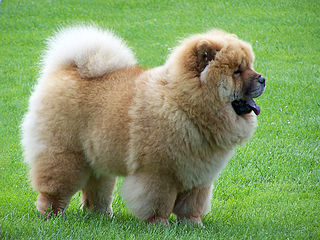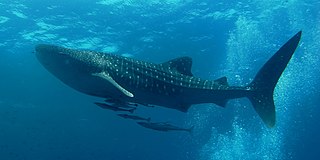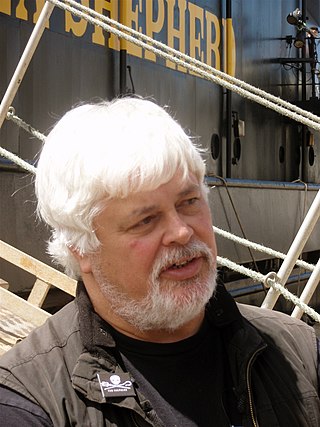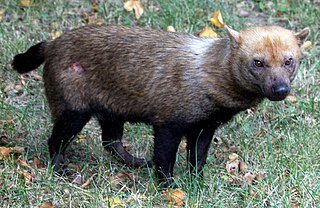
Canidae is a biological family of dog-like carnivorans, colloquially referred to as dogs, and constitutes a clade. A member of this family is also called a canid. The family includes three subfamilies: the Caninae, and the extinct Borophaginae and Hesperocyoninae. The Caninae are known as canines, and include domestic dogs, wolves, coyotes, foxes, jackals and other species.

The Chow Chow is a spitz-type of dog breed originally from Northern China. The Chow Chow is a sturdily built dog, square in profile, with a broad skull and small, triangular, erect ears with rounded tips. The breed is known for a very dense double coat that is either smooth or rough. The fur is particularly thick in the neck area, giving it a distinctive ruff or mane appearance. The coat may be shaded/self-red, black, blue, cinnamon/fawn, or cream.

The German Shepherd, also known in Britain as an Alsatian, is a German breed of working dog of medium to large size. The breed was developed by Max von Stephanitz using various traditional German herding dogs from 1899.

Canine distemper virus (CDV) is a viral disease that affects a wide variety of mammal families, including domestic and wild species of dogs, coyotes, foxes, pandas, wolves, ferrets, skunks, raccoons, and felines, as well as pinnipeds, some primates, and a variety of other species. CDV does not affect humans.

The Black-footed ferret, also known as the American polecat or prairie dog hunter, is a species of mustelid native to central North America.

The whale shark is a slow-moving, filter-feeding carpet shark and the largest known extant fish species. The largest confirmed individual had a length of 18.8 m (61.7 ft). The whale shark holds many records for size in the animal kingdom, most notably being by far the most massive living non-cetacean animal. It is the sole member of the genus Rhincodon and the only extant member of the family Rhincodontidae, which belongs to the subclass Elasmobranchii in the class Chondrichthyes. Before 1984 it was classified as Rhiniodon into Rhinodontidae.

Paul Franklin Watson is a Canadian-American environmental, conservation and animal rights activist, who founded the Sea Shepherd Conservation Society, an anti-poaching and direct action group focused on marine conservation activism. The tactics used by Sea Shepherd have attracted opposition, with the group accused of eco-terrorism by both the Japanese government and Greenpeace. Watson is a citizen of Canada and the United States.

A police dog, also known as a K-9, is a dog that is trained to assist police and other law enforcement officers. Their duties may include searching for drugs and explosives, locating missing people, finding crime scene evidence, protecting officers and other people, and attacking suspects who flee from officers. The breeds most commonly used by law enforcement are the German Shepherd, Belgian Malinois, Bloodhound, Dutch Shepherd, and Labrador Retriever. In recent years, the Belgian Malinois has become the leading choice for police and military work due to their intense drive, focus, agility, and smaller size, though German Shepherds remain the breed most associated with law enforcement.

The bush dog is a canine found in Central and South America. In spite of its extensive range, it is very rare in most areas except in Suriname, Guyana and Peru; it was first described by Peter Wilhelm Lund from fossils in Brazilian caves and was believed to be extinct.

A detection dog or sniffer dog is a dog that is trained to use its senses to detect substances such as explosives, illegal drugs, wildlife scat, currency, blood, and contraband electronics such as illicit mobile phones. The sense most used by detection dogs is smell. Hunting dogs that search for game, and search and rescue dogs that work to find missing humans are generally not considered detection dogs but fit instead under their own categories. There is some overlap, as in the case of cadaver dogs, trained to search for human remains.

The New Guinea singing dog or New Guinea Highland dog is an ancient (basal) lineage of dog found in the New Guinea Highlands, on the island of New Guinea. Once considered to be a separate species in its own right, under the name Canis hallstromi, it is closely related to the Australian dingo. The dog is relatively unusual among canines; it is one of the few to be considered "barkless", and is known for the unusual "yodel"-like style of vocalizing that gives it its name.

The Dobermann is a German breed of medium-large domestic dog of pinscher type. It was originally bred in Thuringia in about 1890 by Louis Dobermann, a tax collector. It has a long muzzle and – ideally – an even and graceful gait. The ears were traditionally cropped and the tail docked, practices which are now illegal in many countries.

The short-eared dog, also known as the short-eared zorro or small-eared dog, is a unique and elusive canid species endemic to the Amazonian basin. This is the only species assigned to the genus Atelocynus.

Canine influenza is influenza occurring in canine animals. Canine influenza is caused by varieties of influenzavirus A, such as equine influenza virus H3N8, which was discovered to cause disease in canines in 2004. Because of the lack of previous exposure to this virus, dogs have no natural immunity to it. Therefore, the disease is rapidly transmitted between individual dogs. Canine influenza may be endemic in some regional dog populations of the United States. It is a disease with a high morbidity but a low incidence of death.

Laurence Norwood Trimble was an American silent film director, writer and actor. Trimble began his film career directing Jean, the Vitagraph Dog, the first canine to have a leading role in motion pictures. He made his acting debut in the 1910 silent Saved by the Flag, directed scores of films for Vitagraph and other studios, and became head of production for Florence Turner's independent film company in England (1913–1916). Trimble was most widely known for his four films starring Strongheart, a German Shepherd dog he discovered and trained that became the first major canine film star. After he left filmmaking he trained animals exclusively, particularly guide dogs for the blind.

The dog is a domesticated descendant of the wolf. Also called the domestic dog, it was domesticated from an extinct population of wolves during the Late Pleistocene, over 14,000 years ago by hunter-gatherers, prior to the development of agriculture. The dog was the first species to be domesticated by humans. Experts estimate that due to their long association with humans, dogs have expanded to a large number of domestic individuals and gained the ability to thrive on a starch-rich diet that would be inadequate for other canids.

César Felipe Millán Favela is a Mexican-American dog trainer. His television series Dog Whisperer with Cesar Millan was produced from 2004 to 2012 and is broadcast in more than 80 countries worldwide.
Canine reproduction is the process of sexual reproduction in domestic dogs, wolves, coyotes and other canine species.
Steve Austin is an Australian dog trainer, who has been training dogs for over 30 years. He is renowned as one of Australia's top animal trainers, with a particular skill in dog behaviour and training. His lifetime in dog training has seen him train animals for quarantine, search and rescue, police work, and wildlife preservation, among other roles. He has also travelled internationally lecturing and training dogs.

Whale feces, the excrement of whales, has a vital role in the ecology of oceans, earning whales the title of "marine ecosystem engineers." This significant ecological role stems from the nutrients and compounds found in whale feces, which have far-reaching effects on marine life.

















